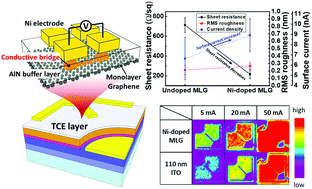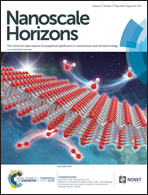Electrically-doped CVD-graphene transparent electrodes: application in 365 nm light-emitting diodes
Abstract
Electric-field-induced doping treatment is applied to a monolayer graphene (MLG) film to improve its usability as a transparent conductive electrode (TCE). Ni is used as a doping source, which produces conductive bridges consisting of ionized Ni by electro-migration from an Ni pad to the as-transferred chemical vapor deposition grown MLG films through AlN buffer layers, by applying voltages of 3.62 ± 0.34 V. As a result, the sheet resistance of the MLG reduces from 712 ± 75.2 Ω sq−1 to 216 ± 46.1 Ω sq−1 and the surface current increases from 6.63 ± 2.07 nA to 8.91 ± 1.62 nA. Additionally, the work function of the MLG increases from 4.36 eV to 5.0 eV due to p-type doping effects. The intercalation of Ni atoms into the MLG is directly confirmed by X-ray photoelectron spectroscopy and Raman spectrum analyses. Finally, the Ni-doped MLG is utilized as the TCE layer for 365 nm light-emitting diodes, exhibiting much better optical properties compared to a standard LED with a 100 nm-thick indium tin oxide electrode.



 Please wait while we load your content...
Please wait while we load your content...